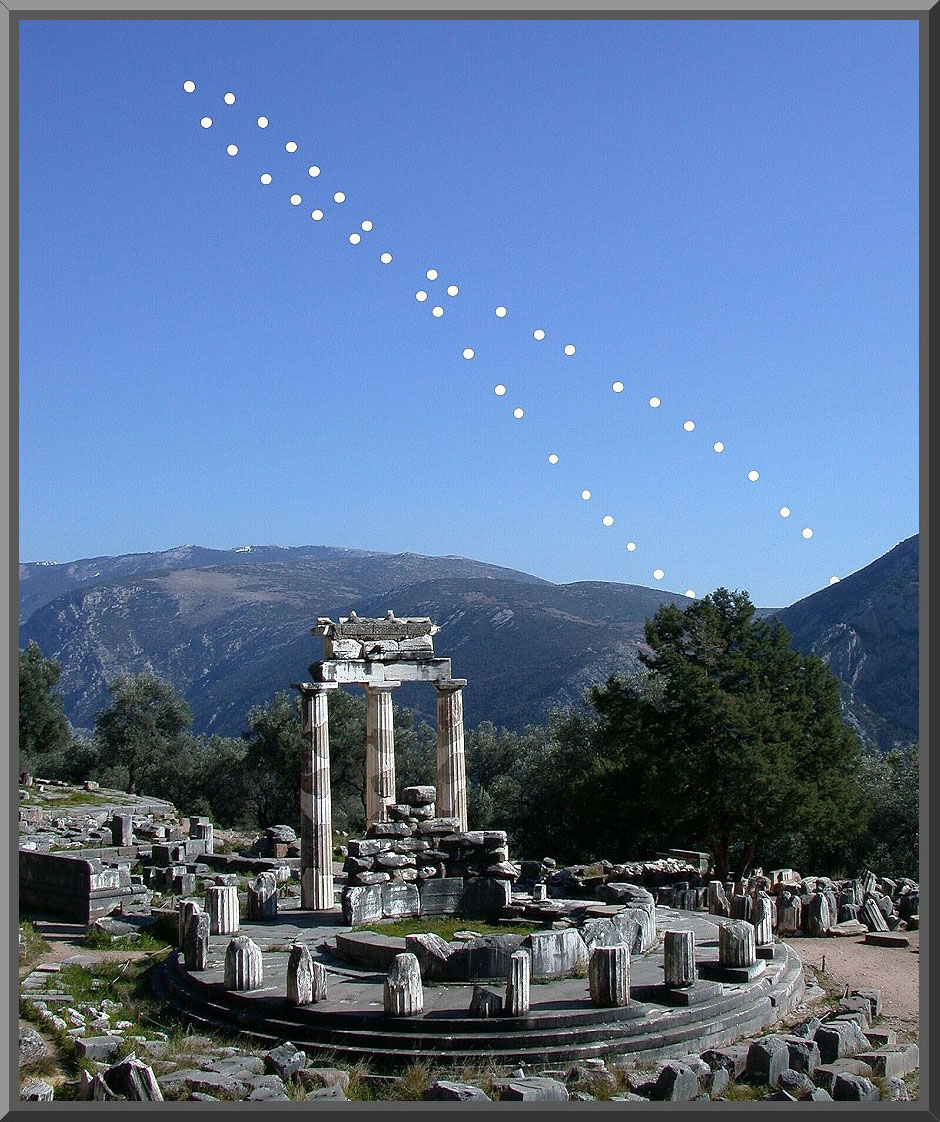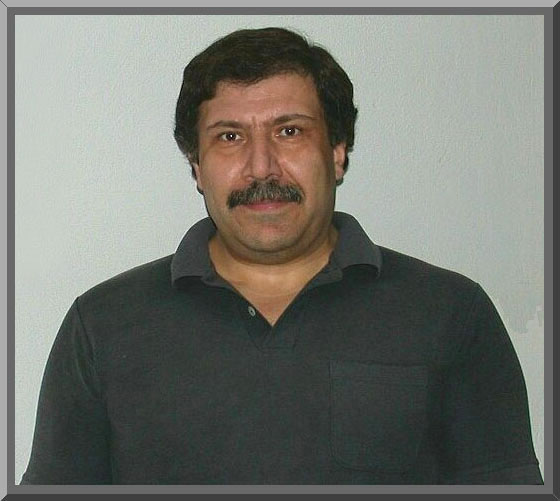|

Anthony's magnificent Analemma at Delphi
(photo from:
http://www.perseus.gr/Astro-Solar-Analemma-060000.htm )
more analemmas at:
http://www.perseus.gr/Astro-Solar-Analemma.htm
The
Analemma
.
"... more
men have walked on the moon than have successfully photographed
the analemma."
(Sky&Telescope, Dec/2003: 73)
An analemma
is basically the figure "8" loop that results when one observes the
position of the sun at the same time during the day over the course
of a year. As a result of the earth's tilt about its axis (23.5°)
and its elliptical orbit about the sun, the location of the sun is
not constant from day to day when observed at the same time on each
day over a period of twelve months. Furthermore, this loop will be
inclined at different angles depending on one's geographical
latitude.
(http://www.perseus.gr/Astro-Solar-Analemma-060000.htm)
The Oracle of
Delphi
Built around a
sacred spring located in a dramatic setting on
the slopes of Mt. Parnassos, Delphi was regarded in antiquity as
the "omphalos" or
center of the world. Its Oracle, dating back to1400
BC, was the most important shrine in all Greece. People came from
all over Greece and beyond to have their questions about the future
answered by Pythia, the priestess of Apollo.
ref:
http://www.perseus.tufts.edu/cgi-bin/siteindex?entry=Delphi |
Contact information
website
http://www.perseus.gr
.
email
Linked on his website
Biography
I
am a 41 year-old retired computer consultant (system design) from
Athens, Greece.
My college and graduate school education was at the
Universities of Toronto and Waterloo (Canada)
where I received the B.Sc. degree in statistics and computer science, BA
(computer science) and BMath (mathematics). In grad school I received the
MSc (statistics), MHSc (public health and epidemiology) and M.Ed.
(computer science).
My interest
in astronomy is perhaps typical of other amateur astronomers as it dates
back to my early youth. Perhaps the germinating seed that initiated a
tremendous fascination for the wonders beyond our planet was NASA's manned
space program and, more specifically, the Apollo series during the late
1960's which, of course, was captivated by the Apollo 11 mission on July
20th, 1969 with the famous "the
Eagle has landed" (at:16:17:00 Universal Time-4) and followed a
few hours thereafter by "one
small step for man, one giant leap for mankind" (at: 22:56:15 Universal Time -4). Regrettably, commitments
to university studies followed by consulting work
necessitated that I somehow keep this incessant and burning passion in the
background and it was not until until my late thirties that I finally had the financial means
and time to pursue astronomy as a hobby.
My first
telescope was Celestron 14"/f11 Schmidt-Cassegrain. The telescope coupled with an
interest in photography that was initiated in high school led me
inevitably to astrophotography.
The bulk of my astroimaging is performed at my cottage-villa on the northeast
outskirts of Athens where skies easily reach a limiting visual magnitude
of 4.5 and which comfortably exceed 5.0 during winters. For example, Ursa
Minor is usually visible in its entirety with/without averted vision; the
Milky Way is a beautiful site year-round and an incessant reminder about
the richness of the heavens above. When in pursuit of even darker skies, my favorite location is the absolute top of Mount Kithaironas (1430 m),
approximately 90 km northwest of Athens.
Regarding my equipment, I was finally notified (after 5-years on the AP
waiting list) that I will soon receive an Astro-Physics 160 mm/f7.5 EDF
air-spaced triplet refractor. I am still waiting for
an Astro-Physics Traveller (105 mm/f6) ordered in Feb/2002. I also own a semi-apochromatic
refractor (TeleVue Pronto) as well as a rich-field refractor (Orion
ST-80WA).
Areas of interest
Astrophotography involving:
celestial mechanics (analemma, time series etc) and
challenging Deep Sky Objects like Abell PNe, Arp catalog and Barnard's
Dark Nebulae
Astrophotography publications
see:
http://www.perseus.gr/Astro-Pubs.htm
Magazine Articles
Amateur Astronomy (USA),
Astronomi (Norway), Coelum
Astronomia (Italy),
Griffith Observatory (USA),
Nojum Magazine (Iran),
Ouranos (Greece), Popular Astronomy (Britain), Sky&Space (Australia) and
Star Observer (Austria)
Magazine Photos
Air & Space
(USA) , al-MAGELLA al-FALAKYYA (Italy/Arabic Edition), Astronomi (Norway),
Astronomie Heute (Germany), Astronomy (USA), Astronomy Now (Britain),
Astrosurf (France), Sky & Telescope (Australia), Ciel & Espace (France),
Coelum Astronomia (Italy), Γεωτρόπιο (Greece), Focus Magazine (UK), Le
Stelle (Italy), Luna (Britain), Newton Magazine (Italy), NVOX (Holland),
Ουρανός (Greece), Planetarian (USA), Popular Astronomy (Britain), Popular
Science (Greece), Recorder (Canada), Sky & Space (Australia),
Sky&Telescope (USA), Sky At Night (Britain), Star Observer (Austria),
Tahdet ja avaruus (Finland), The Technology Teacher (USA), Urania
(Poland), Zenit (Holland-Belgium) and Zvezdotchet Magazine (Russia)
Books,
Encyclopaedia, Multi-Media, Mass Media, Television, Web Sites and more
See:
http://www.perseus.gr/Astro-Pubs.htm
Observing sites
Home
Site
Near Athens, Greece at
38.2997° N, 23.6430° E; with a limiting magnitude of at least 4.5 to 5.0.
Remote Sites
Excursions
include frequent trips to Mt Kithairona (38.1831° N,
23.2486° E, 1431 m altitude) year-round and Mt
Parnonas (1700+ m) in southwestern Greece during summers.
Astronomical Equipment
Telescopes
Celestron 14" SCT/f11
Astro-Physics Starfire160 at f/7.5
Takahashi FSQ-106N f5 (on order)
Mounts
Losmandy G-11
Paramount ME (on order)
CCD/Cameras
SBIG ST-20000XM
Canon EOS 300D SLR Digital Rebel camera
Philips ToUCam PCVC 740k webcam
Software
AIP4Win, CCDSoft, Maxim DL,
Photoshop and Registax
Activity
Retired systems analyst and designer
|

